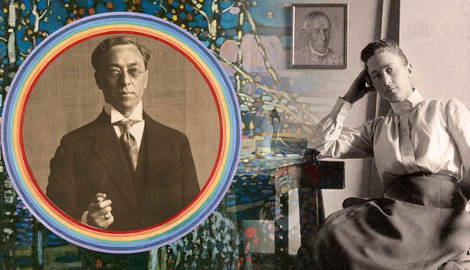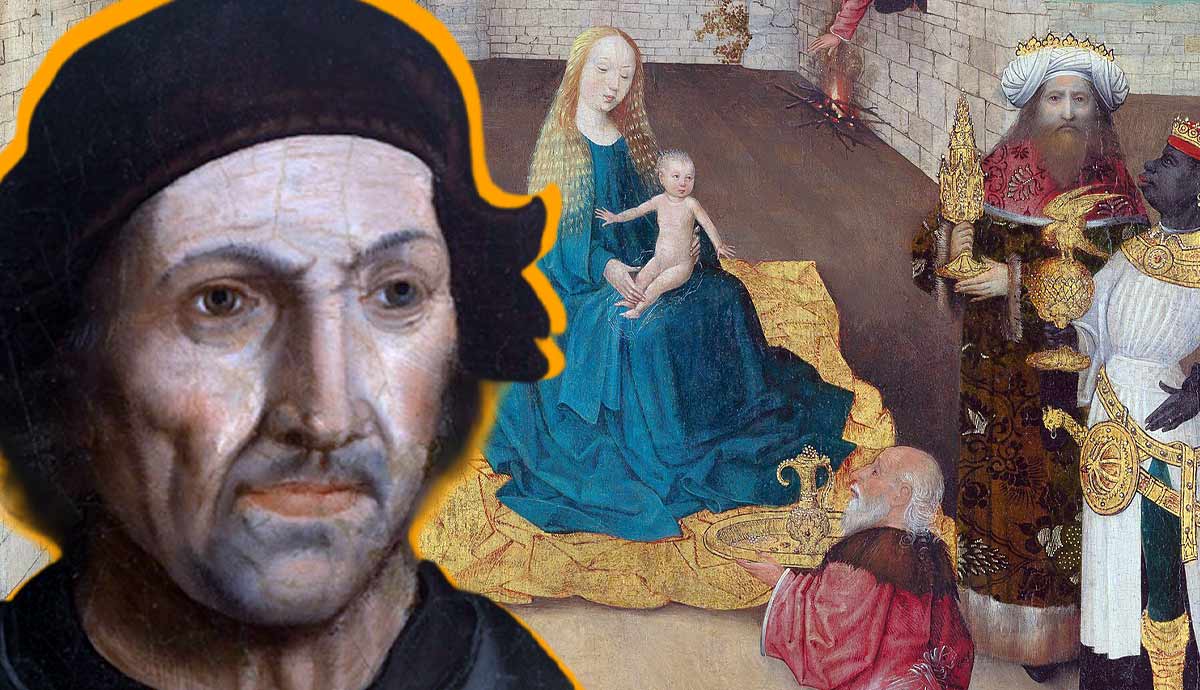
Before the rediscovery of the Swedish artist Hilma af Klint, it was believed that Wassily Kandinsky was the first modern artist to turn to abstraction. However, there is a theory suggesting that Kandinsky was actually influenced by Hilma af Klint’s works, which he might have seen years before moving to abstract art himself. Read on to learn more about this fascinating theory.
Hilma af Klint, the Forgotten Pioneer of Abstract Art

The gradual shift from figurative to abstract art is one of the most researched and debated aspects in art history. However, there is still enough room for debate and there are many questions left unanswered. For years, it was believed that a Russian-born artist Wassily Kandinsky was the first western artist to turn to abstract art, with his 1910 Untitled watercolor. The date is however questionable, since Kandinsky dated his paintings himself, and, reportedly, misattributed some works on purpose. In 1986, with the rediscovery of the works by a Swedish occultist Hilma af Klint, the narrative gradually started to change.

There were several issues with adding Hilma af Kint to the art historical canon. First of all, the artist worked in almost complete isolation. She rarely exhibited her works, and when she did, these exhibitions were mostly spiritualist gatherings rather than traditional art shows. Another difficult point was establishing a connection between af Klint and the rest of the art world was her own artistic practice, based on automatic drawing and the practice of mediumship. Her methods separated her from the art historical narrative much more than her self-isolation.

Although she was a trained artist, making a living doing portraits and botanical illustration, the occult connotations of her independent work, as well as her alleged contact with higher beings, was off-putting for many conservative art historians and curators. Another reason for a reluctant acceptance of Hilma af Klint could perhaps be found in the conditions of the art market. The artist’s will stated that her works were supposed to be kept together and never separated, which ruled out the possibility of works being bought or sold.

However, as more and more details of Hilma af Klint’s life become uncovered, her art attracts a growing number of admirers. The recently translated biography of Hilma af Klint by art historian Julia Voss sheds light on the artist’s life and her artistic methods, finally doing af Klint the justice she deserved. According to af Klint herself, her abstract paintings were the result of conversations with the Higher Masters. One of the beings called Amaliel allegedly contacted her during a spiritual seance in 1904, revealing that af Klint had a mission of bringing higher spiritual knowledge into the human world.
Over the years, she conveyed these messages on canvases, trying to intervene as little as possible. Some of her paintings of that period showed anthropomorphic figures painted with obvious flaws in anatomy. It is unlikely that af Klint, a trained portraitist, would have left such errors without corrections if it was not for some reason behind it.
Another pioneer of abstract art, Wassily Kandinsky, who was also interested in the occult, had another remarkable feature that possibly allowed him to escape the boundaries of figurative art. Kandinsky himself experienced a rare neurological phenomenon called synesthesia, where one sensory pathway in the human brain becomes triggered by the stimulation of another. In other words, synesthetes can hear or taste color, or associate letters and numbers with different sounds.
In Kandinsky’s case, he was able to identify colors and shapes with the sounds of musical instruments. His abstract compositions were far from af Klint’s semi-automatic images. His compositions were carefully arranged in accordance with his own feelings and sensations. But, in order to clearly establish the possible connection between Hilma af Klint’s works and Wassily Kandinsky’s early abstractions, we need to add another person to the equation.
Who Was Rudolf Steiner?

Rudolf Steiner, an Austrian-born philosopher, was one of the leading figures of European spiritualism. A literary critic, prolific writer, esotericist, and reformer, he based his theories mostly on the writings of Johann Wolfgang Goethe and the Christian culture. A prominent figure in the Theosophical society, he left in 1912 due to the overwhelming focus of the Theosophists on Eastern religions. Soon Steiner and his followers formed the Anthroposophical society, the Christian alternative to Theosophy, which also focused on the quasi-scientific exploration of the world, overlapping with spiritual practices.

Steiner was an artist himself. However, art was never his primary occupation. He was working with wooden sculpture, watercolor painting (through his own method called veil painting), and blackboard drawings, which were sitting in the intersection of chalk scribbles, sometimes reminiscent of Cy Twombly’s works, and scientific diagrams.
Hilma af Klint and Rudolf Steiner

Steiner was a well-known figure in Europe and the United States, touring both continents with a series of lectures. Hilma af Klint attended at least one of them in Stockholm. It was soon after the lecture that af Klint wrote Steiner a letter inviting him to her studio to see her paintings. Guided by the invisible forces, af Klint nevertheless had little understanding of how to interpret her own works and needed spiritual guidance from someone more experienced. In 1908, Steiner finally came for a visit, although the outcome of his arrival was most likely unexpected by af Klint.

Unfortunately, there is little documentation of what exactly happened during the meeting. By some accounts, Steiner was uninterested and disappointed, specifically disapproving of af Klint’s practice of mediumship. Most Theosophists regarded mediumship as a misinterpretation of the messages from the spiritual world and a dangerous practice based on hallucinations. Whatever happened during the meeting, one thing is known for sure: after Steiner’s departure, af Klint entered a four-year painting hiatus.
Another detail hinting at the fact that the conversation was not as pleasant as af Klint wanted it to be, is the lack of its documentation. Af Klint originally intended for her notes and diaries to be published, so she painstakingly edited them and tried to preserve as many details as possible. Therefore, it was unlikely for her to leave such an important meeting with barely any evidence.
Wassily Kandinsky’s Potential Inspiration

During that meeting in 1908, Hilma af Klint gave Steiner several photographs of her works, which he took with him on his subsequent travel destinations. The same year, Steiner met Wassily Kandinsky in Germany. At that time, Kandinsky was still relatively far from abstraction in his artistic practice, working mostly on landscapes, heavily inspired by the Russian folk art tradition. Although there is no definitive proof of him seeing af Klint’s work, it is interesting that at this time he started being more interested in spiritualism and occultism, joining the Theosophical Society in 1909.

According to Kandinsky’s notes, his departure to abstract art happened around 1910, soon after his conversation with Steiner. Therefore, there is a small yet significant chance that he was inspired by the works of the then-unknown Swedish painter. Some art historians, including the biographer of Hilma af Klint Julia Voss, believe that this version might be true, and can possibly open a new chapter in the long and unfair story of misattributing women’s achievements in art to their male counterparts.
Unlike af Klint, Kandinsky paid a lot of attention to the theory of art and the justification of his methods. In 1910, he finished one of his most important theoretical texts called Concerning the Spiritual in Art. In this work, Kandinsky announces the supremacy of meaning over form and the importance of prioritizing the spiritual component in modern art.
Was Hilma af Klint Really the First Abstract Artist?

Although the theory sounds compelling, there is unfortunately not enough evidence to back it up definitively. Even more so, the question of the origins of abstract art gets even more complicated when we take into account the Islamic tradition of non-representational painting. For centuries, Islamic artists were experimenting with geometrical shapes due to the notion of aniconism or the prohibition of realistic imagery of God’s creations like humans, plants, or animals. However, even while talking about Western art specifically, there are still enough questions unanswered. The late rediscovery of Hilma af Klint’s work raises another type of question: are there any other artists forgotten by history, whose works could have potentially altered the cannon in the same dramatic way?









